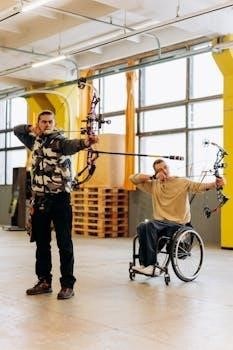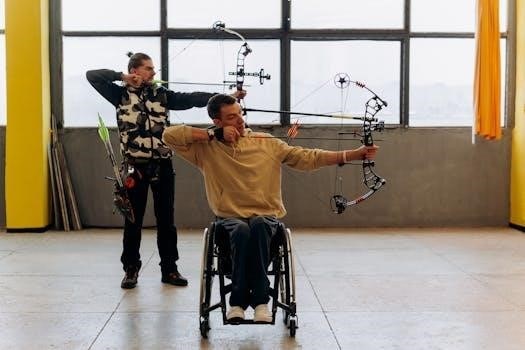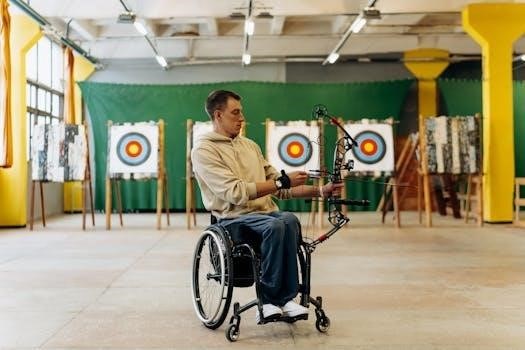Overview of Olympic Triathlon Training Plans
Olympic triathlon training plans provide structured guidance for athletes aiming to complete a 1․5km swim, 40km bike, and 10km run․ These plans range from 8 to 24 weeks, offering varied durations to suit different fitness levels and preparation time․ They are designed to build endurance and fitness progressively․
Understanding the Need for a Structured Plan
A structured training plan is paramount for success in an Olympic distance triathlon․ It moves beyond casual workouts, providing a focused approach to improve performance․ Without a plan, athletes risk overtraining, undertraining, or injury due to lack of progression․ A well-designed plan incorporates the varied disciplines of swimming, cycling, and running, ensuring balanced development․ It helps athletes gradually build endurance, strength, and speed, targeting specific areas for improvement․ This structure allows for effective time management, balancing training with other life commitments․ A plan also includes rest and recovery periods, crucial for muscle repair and preventing burnout․ It allows for tracking progress, identifying weaknesses, and adjusting strategies․ Following a structured plan ensures that each workout has a purpose, contributing to the overall goal of completing the triathlon effectively․ A structured approach provides the necessary direction and motivation for consistent training, maximizing the athlete’s potential․ Finally, it builds confidence as the athlete sees their progress and readiness for the race․ Ultimately, a well-planned training schedule is key to a safe, successful and enjoyable triathlon experience․
Different Training Plan Durations (8-week, 12-week, 24-week)
Olympic triathlon training plans come in various durations, primarily 8, 12, and 24 weeks, catering to different levels of experience and available preparation time․ An 8-week plan is typically suited for athletes with a solid fitness base, requiring intense workouts and minimal rest․ It’s a condensed approach for those who are already fairly fit and need a focused plan․ A 12-week plan is a more common choice, offering a balanced approach between intensity and recovery․ It provides ample time to build endurance and speed, suitable for intermediate athletes․ This duration allows for progressive training and adaptation to the demands of the sport․ A 24-week plan is designed for beginners or those with less experience, focusing on gradual development of fitness․ It offers a more relaxed pace, allowing ample time for building a strong aerobic base․ This longer duration includes more rest and recovery, reducing the risk of overtraining and injury․ The choice of duration depends on individual fitness levels, goals, and available training time, impacting the overall structure and intensity of the plan․ Therefore, selecting a plan that matches your current fitness is crucial for success․

Training Plan Components
A comprehensive training plan includes swimming, biking, and running workouts, with specific sessions tailored to each discipline․ Brick workouts, combining bike and run, are also essential․ These components ensure a well-rounded approach to triathlon preparation, focusing on all required skills․
Swim Training Specifics
Swim training in an Olympic triathlon plan is crucial, focusing on building both endurance and speed in the water․ Typical sessions often include drills to improve technique, such as catch-up, fist drills, and single-arm swimming, which enhance stroke efficiency and power․ Interval training, with varying distances and intensities, is also a key component, helping to increase your aerobic capacity and speed․ Open water swimming practice is vital, especially closer to race day, to adjust to the conditions and practice sighting․ It is suggested that you include at least two open water swims before the race․ Workouts may also incorporate sets at different paces, from easy warm-ups to hard efforts, to simulate race conditions․ The goal is to enhance your overall swimming ability, giving you the confidence to tackle the swim portion of the race․ Additionally, recovery swims are important for muscle repair and relaxation․
Bike Training Specifics
Bike training in an Olympic triathlon plan involves a mix of endurance rides, speed work, and hill training․ The plan should include two to three bike sessions per week, focusing on gradually increasing distance and intensity․ Endurance rides help build the aerobic base needed for the race, while speed sessions improve leg turnover and power output․ Hill training is essential for strengthening leg muscles and preparing for varied terrains․ Interval training with short, fast bursts and longer tempo efforts is also vital․ Additionally, some workouts may involve riding in different gears and cadences to improve efficiency․ It is important to build rides gradually․ Practicing transitions from the bike to the run is also crucial․ Attention to bike handling skills, such as cornering and descending, is also an important factor․ It is suggested to include some brick workouts, which involve immediately running after cycling․
Run Training Specifics
Run training for an Olympic triathlon focuses on building both endurance and speed, with two to three sessions per week․ The plan should include a mix of easy runs, tempo runs, and interval workouts․ Easy runs build your aerobic base and improve recovery․ Tempo runs are sustained efforts at a comfortably hard pace, helping to improve your lactate threshold․ Interval training involves short bursts of fast running with recovery periods, enhancing your speed and efficiency․ Hill training is also important for building strength and simulating race conditions․ A crucial aspect of run training is incorporating brick workouts, which simulate the transition from cycling to running․ It’s important to gradually increase the mileage over the weeks․ Focus should also be placed on running form and technique to avoid injuries․ Proper pacing is crucial during training․ Additionally, some training plans include practice runs on different terrains to prepare for various race conditions․
Importance of Brick Workouts
Brick workouts, which combine cycling and running back-to-back, are essential for Olympic triathlon training․ These workouts simulate the transition from the bike to the run, a crucial aspect of race day․ They help your body adapt to running on tired legs after cycling․ This simulates the fatigue experienced during the actual triathlon, allowing your body to adjust․ Regular brick sessions improve your running efficiency and reduce the risk of experiencing heavy legs․ These sessions improve your body’s ability to transition from one discipline to the next․ They also help you practice pacing for the run leg after the bike․ Brick workouts can vary in length and intensity and should be incorporated in the training plan at least once a week․ They also allow you to practice your transition process․ This allows the athlete to optimize their transition speed and efficiency․ It is crucial to include brick workouts to prepare the body for the unique challenges of a triathlon․

Training Plan Levels and Goals
Training plans cater to beginner, intermediate, and advanced athletes, each with specific goals․ Beginner plans focus on finishing, while intermediate plans aim for improved times․ Advanced plans target peak performance and competition․ These plans are structured to meet varied needs․
Beginner Training Plans
Beginner training plans for Olympic distance triathlons are designed for individuals new to the sport or those with limited experience․ These plans prioritize building a solid aerobic base and gradually increasing training volume․ They typically span 12 weeks, assuming the athlete can already swim a short distance, bike for a short period, and run for a shorter duration, though not consecutively․ The focus is on consistency and technique rather than speed and intensity․ A typical week includes two sessions each of swimming, biking, and running, along with a brick workout, which combines biking and running․ These plans emphasize finishing the race comfortably and building confidence․ They include detailed guidance on how to use heart rate zones and fuel the body for optimal performance and recovery․ Beginners should focus on mastering the basics, such as smooth transitions and efficient form in each discipline․ Open water swimming is introduced gradually to build comfort and confidence in a race-like setting․ The goal is to complete the triathlon safely and enjoyably, laying a foundation for future improvements․
Intermediate Training Plans

Intermediate training plans are tailored for athletes with some triathlon experience, who are comfortable with the distances involved in an Olympic triathlon․ These plans typically span 12 weeks and aim to enhance performance and maximize potential․ They assume the athlete can swim 1600 meters, ride for 90 minutes, and run for 45 minutes, although not consecutively․ The focus shifts towards improving speed and endurance while maintaining a balanced training schedule․ These plans incorporate more intense workouts, including interval training and tempo runs, to push the athlete’s limits․ They also emphasize the importance of brick workouts to simulate race conditions․ Intermediate plans often involve two to three swim, bike, and run sessions each week, with a brick workout included․ These plans provide detailed guidance on technique, intensity zones, and fueling strategies to optimize performance on race day․ Athletes are expected to have a good understanding of the basic techniques and are ready to refine their skills․ Open water swimming is crucial and should be practiced regularly․ The goal is to achieve a personal best and compete at a higher level․
Advanced Training Plans
Advanced training plans are designed for experienced triathletes aiming for peak performance and competitive results in Olympic distance triathlons․ These plans are intense and demanding, often spanning 24 weeks or more, and assume a high level of fitness and triathlon-specific skills․ They incorporate advanced training techniques, such as high-intensity interval training (HIIT), threshold workouts, and strategic periodization, to maximize speed, power, and endurance․ Advanced plans typically include multiple sessions per week for each discipline, with a strong emphasis on brick workouts and open water swimming․ These plans delve deeper into the science of training, incorporating detailed heart rate zones, pace targets, and recovery protocols․ They often include strength training to enhance power and prevent injuries․ Advanced training requires a significant time commitment and a dedication to a structured routine․ These plans are not for beginners and assume the athlete has a strong foundation in triathlon training․ The focus is on fine-tuning performance, optimizing race strategy, and achieving personal bests at the highest level of competition․ Open water swims and brick workouts are essential components of advanced training plans․

Key Considerations
Key considerations include open water swimming practice, strength training integration, and the importance of rest and recovery․ These elements are crucial for preventing injuries, enhancing performance, and ensuring overall success in an Olympic distance triathlon․ Ignoring them could lead to setbacks․
Importance of Open Water Swimming
Open water swimming is a vital component of Olympic triathlon training, differing significantly from pool swimming․ Unlike the controlled environment of a pool, open water presents challenges such as varying water temperatures, currents, waves, and limited visibility․ Practicing in open water allows athletes to adapt to these conditions, improving their sighting skills, which are crucial for maintaining a straight course and avoiding unnecessary distance․ Furthermore, open water swims help athletes develop confidence in navigating the unpredictable environment, reducing anxiety on race day․ It also allows them to adjust to swimming with others, which can be chaotic at the start of a triathlon․ Incorporating open water sessions into a training plan, at least a couple of times before the race, is essential for acclimatization․ This practice enhances the athlete’s ability to handle the unique demands of the open water swim section of the triathlon effectively and efficiently, thus improving their overall performance․
Strength Training Integration
Integrating strength training into an Olympic triathlon training plan is crucial for injury prevention and enhanced performance․ Strength work helps build a robust musculoskeletal system, enabling athletes to withstand the rigors of training and racing․ It targets key muscle groups used in swimming, cycling, and running, thus improving power output and efficiency in these disciplines․ A well-structured strength program should include exercises that focus on core stability, leg strength, and upper body endurance․ This type of training is not about bulk, but rather about building functional strength that translates to improved athletic performance and reduced risk of injuries․ Strength training is also essential for maintaining proper form during endurance activities, minimizing fatigue, and optimizing the athlete’s ability to sustain effort for longer periods․ It should be incorporated strategically throughout the training cycle to complement the swim, bike, and run workouts, not as a separate entity․
Rest and Recovery in Training
Rest and recovery are integral components of any effective Olympic triathlon training plan, crucial for preventing overtraining and maximizing performance gains․ Adequate rest allows the body to repair and rebuild muscle tissue, replenish energy stores, and adapt to the training load․ Ignoring recovery can lead to fatigue, injuries, and decreased performance․ A well-structured plan should incorporate rest days, where complete rest or light activity is scheduled․ Furthermore, sufficient sleep is vital for physical and mental recovery, playing a crucial role in hormone regulation and muscle repair․ Active recovery methods like light stretching and low-intensity activities can also aid in reducing muscle soreness and improving circulation․ Proper nutrition and hydration are also essential for recovery․ Listening to your body’s signals and adjusting the training plan as needed is important to ensure adequate recovery and avoid burnout․ A balanced approach to training and recovery ensures long-term progress and overall well-being․
